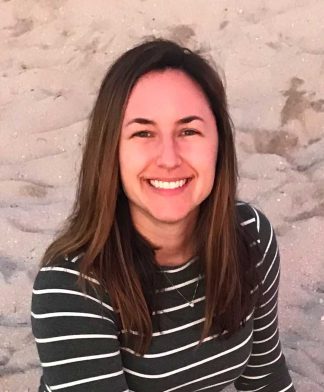By Allison Campbell-Jensen
The Occupational Therapy program launched a new entry-level doctoral program in fall 2019 with a new curriculum. As a result, the existing course in assistive technology and orthotics was updated, according to Assistant Professor Tamara Vos-Draper, Ph.D., OTR/L, ATP/SMS. “Because 3D printing is becoming increasingly common in OT practices as an available tool, we determined that learning about it should be included in our new curriculum,” she says.
Prior to participating in that assistive technology class this spring, OT student Katelyn Marthaler was really excited to learn 3D printing. She says her passion is assistive technology. For her fellow student Melissa Glynn, however, the prospect seemed very intimidating.
“I had some friends in my undergrad who had a 3D printer, but it seemed like such a foreign concept to me,” she says. A pre-class survey revealed to Vos-Draper that other students had concerns about using the technology.
Had they purchased 3D printers for the student cohorts in the Twin Cities and Rochester this spring, faculty would have needed to spend time learning how to use them. In addition, “with the reduced on-campus time this past year, we weren’t sure how we would be able to accommodate in-person 3D printing,” she says.
Fortunately, Jonathan Koffel, Emerging Technology and Innovation Strategist in the Libraries, had met earlier with one OT student curious about the Makerspace, which includes 3D printers. She invited him to meet with all her fellow students and the department head. From that gathering, Koffel was introduced to Vos-Draper.
“She had a lot of good content around what 3D printing was and how it could be used in OT,” he says. “But she didn’t have a strong background in the 3D design portion or have access to 3D printers. The library had been developing these skills for years and so was able to help out”
Learning a new tool
The job has not changed; only the tools have.
“Occupational therapists adapt tasks and environments for individuals to improve function and participation. Adaptations often require customization to meet unique needs,” Vos-Draper says. “3D printing is one way to create individualized customizations and it is becoming increasingly common to find 3D printers where OTs practice.”
While OTs have used thermoplastics, foam, and repurposed objects to develop devices to help their clients, 3D printing also requires learning technology.
Koffel “provided thoughtful and detailed videos and tutorials for each step of the 3D printing process that I included in the course modules,” Vos-Draper says. “We began with simple tutorials in use of CAD software to modify existing pillbox designs to accommodate low vision and impaired hand dexterity, progressed to students following a tutorial to design an assistive technology device for printing, and finally to students designing an entirely new 3D print design independently.”
Student Ali Miller enjoyed learning the Tinkercad software. She also got into the flow of designing. One of their assignments was to find a previous Tinkercad design and alter it for a client with decreased dexterity in their hands.
“It was a Friday night and I was working away editing [the design] and it was fun,” Miller says. “It was fun to think about specific clients and how this could be made specific to their needs.”
Marthaler found that, after the 3D printing unit was completed, she carried over what she learned to other projects.
“We had a client who had only one hand, and the task that my group had was ironing, so we were able to use 3D printing to make a device for her.”
Looking at the situation with an OT lens, developing a holistic picture of the client in her environment with the goal of making her as independent as possible, the group analyzed every aspect of the task, from plugging in the iron to using the mister button. “If we forget about plugging in, she won’t be able to do [any other part of] that task,” Marthaler says.
Says Vos-Draper: “OTs tend to be highly creative and inventive in finding individualized solutions to improve function.”
The students sent their designs to Koffel’s colleague in the Makerspace, Rami Jubara, who printed out about 47 of them. “They demonstrated phenomenal creativity and 3D modeling skills,” Koffel says.
Benefits of 3D printing
To the future OTs, the benefits of 3D printing are clear.
“In OT we are all about being client centered, so with 3D printing, you can make items that are customizable to the client, whether a new product or a little piece that can be added to something they already own,” Glynn says. These printed adaptations may also be less expensive than other custom approaches, she adds.
They also could be more aesthetically pleasing. “You get to be the mastermind behind it,” Glynn says.
“An OT using 3D printing can design a custom device and then save the file so it can be reprinted in the future as a replacement,” Vos-Draper says. “This saves time and provides more consistency for the client.”
There’s another benefit. Marthaler has friends in engineering who also use 3D printing. “I taught them some things they didn’t know,” she says. “As OTs, we’re able to put the functional aspect into 3D printing.”
Vos-Draper feels positive about the students’ learning. “Through this process, they learned where they can find existing patterns uploaded by other OTs, how to modify them to meet their needs, and where to find 3D printers. They also learned about some of the intricacies around printing various shapes and use of different materials and colors. This experience has prepared them to enter OT practice with a good baseline understanding about how 3D printing can be used to enhance functional performance and tools to use in their practices. I think the experience has helped students feel more confident!”
Marthaler also is enthusiastic.
“3D printing in the OT world is a pretty new thing that not every OT is able to do. I’m just thankful to the U of M for giving us OTs this experience that we will bring into our future careers.”
In the future, Koffel says the assistive technology class will be even better when students can come into the Makerspace.
“They can riff off each other, and we could provide direct support with the design,” Koffel says. “We would have a lot more tools and equipment available. Dr. Vos-Draper and I have talked about trying to integrate electronics into the assistive technology to add additional functionality.”
Says Miller: “I’m excited to have the Libraries back open, so I can come in and keep exploring, to see 3D printing happening in real time.” In the long run, she’ll be better able to create new 3D printed adaptations for her OT clients.







